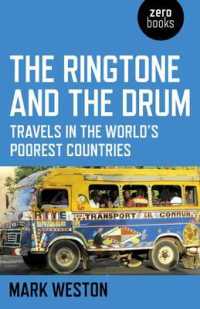- ホーム
- > 洋書
- > 英文書
- > Science / Mathematics
Full Description
Comprising specially selected papers this book presents trans-disciplinary research on issues related to the nature of water, and its use and exploitation by society. The valuable research contained in this book demonstrates the need to bridge the gap between physical, biological, environmental and health sciences.
Water is essential for sustaining life on our planet, nevertheless its unequal distribution is a source of permanent conflict. It is predicted that population growth and irregular rainfall, due to climate change, may lead to more restricted access to water in certain regions of the world. This problem is made even more severe by human actions that can cause degradation to nature and the environment.
The availability of clean and inexpensive water can no longer be taken for granted as the need for water continues to increase due a growing global population. Heavy water consumers such as agriculture and industry often contribute to its contamination. Water distribution networks in urban areas and soiled water collection systems, present serious problems as well as the need to maintain ageing infrastructures. Possible technologically solutions, such as desalination or pumping systems are energy demanding but, as costs rise, the techniques currently developed may need to be re-assessed.
Contents
Contents
Empowerment versus charity in bringing microflush toilets to the poor: sustainable local economies for the common good; Assessing the effectiveness of water and sanitation sector governance networks in developing countries: a policy analysis framework; Sustainability of basin level development under a changing climate; The environmental added value of water: a proposal; Mobile augmented reality for flood events management; Sustainable water management in Kuwait: current situation and possible correctional measures; Analysis for water mitigation options using MCDA: a case study in the Galapagos islands; Impact of groundwater salinity on agricultural productivity with climate change implications; Designing two-part greywater fees: conceptual framework and empirical evidence from Germany; Effects of climate change on water availability for the Usumacinta River environmetal flow (Mexico); Water retention measures - case study from Slovakia; Integrated watershed management and floodplain protection on the Carson River in the western USA; Are the benefits of integrated catchment modelling being realized in the United Kingdom?; Economic, social and environmental vulnerability to drought in the northwest river basin system, Mexico; Local knowledge-based water management and irrigation in the Western Pamirs; Monitoring of seepages in earthen dams and levees; Rack length in bottom intake systems; Micropollutants in stormwater discharge in the Swist River basin; Water quality monitoring in urban basins as support for water resources management: a case study from southern Brazil; Controlling environmental pollution in the urban water cycle; Treatment of manganese in acid and neutral mine drainage using modified dolomite; Historical use of nitrogen and phosphorus fertilizers in rain-fed regions and their consequential implications on water quality in the Pacific Northwest, USA; How does targeted grassing of arable land influence drainage water quality and farm economic indicators?; Hydrologic assessment of woody biomass removal for biofuel production; Retention soil filter for treatment of combined sewer overflow and wastewater treatment plant effluent; Relations between the microscale riverbed morphology and the macrozoobenthos - implications for the ecological quality assessment and the definition of reference conditions; Uncertainty in minimum instream flow requirements for streams in semi-arid environments
Author index








